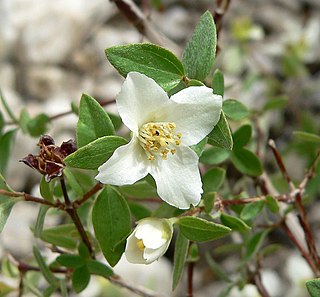
Philadelphus (mock-orange) is a genus of about 60 species of shrubs from 3–20 ft tall, native to North America, Central America, Asia and (locally) in southeast Europe.
Mock orange or mock-orange typically refers to Philadelphus, a mostly Holarctic genus of shrubs, particularly the species Philadelphus coronarius, which is widely cultivated as an ornamental plant.

Aquilegia formosa, the crimson columbine, western columbine, or (ambiguously) "red columbine", is a common wildflower native to western North America, from Alaska to Baja California, and eastward to Montana and Wyoming.

Philadelphus lewisii, the Lewis' mock-orange, mock-orange, Gordon's mockorange, wild mockorange,Indian arrowwood, or syringa, is a deciduous shrub native to western North America, and is the state flower of Idaho.

Chauncey Delos Beadle was a Canadian-born botanist and horticulturist active in the southern United States. He was educated in horticulture at Ontario Agricultural College (1884) and Cornell University (1889). In 1890 the landscape architect Frederick Law Olmsted hired him to oversee the nursery at Biltmore Estate in Asheville, North Carolina on a temporary basis. Olmsted had been impressed by Beadle's "encyclopedic" knowledge of plants. Beadle ended up working at Biltmore for more than 60 years, until his death in 1950. He is best known for his horticultural work with azaleas, and described several species and varieties of plants from the southern Appalachian region. He and three friends, including his "driver and companion" Sylvester Owens, styled themselves the Azalea Hunters. The group traveled over the eastern United States for a period of fifteen years, studying and collecting native plants. In 1940 Beadle donated his entire collection of 3,000 plants to Biltmore Estates.

Lepidium draba, also known as whitetop, hoary cress, or Thanet cress, is a rhizomatous perennial flowering plant in the family Brassicaceae. It is native to western Asia and southeastern Europe and has been widely introduced elsewhere.

Forestiera pubescens, commonly known as stretchberry, desert olive, tanglewood, devil's elbow, elbow bush, spring goldenglow, spring herald, New Mexico privet, or Texas forsythia is a deciduous shrub or small tree native to the southwestern United States and northern Mexico.

Lithospermum canescens, or the hoary puccoon is a perennial herb endemic to eastern North America. The plant grows in a variety of habitats. It has golden yellow flowers which bloom from April to May.

Aquilegia pubescens is a high-altitude species of columbine known by the common names Sierra columbine, alpine columbine and Coville's columbine. Its flowers are large and usually a creamy white.

Philadelphus coronarius is a species of flowering plant in the family Hydrangeaceae, native to Southern Europe.

Tephrosia virginiana, also known as goat-rue, goat's rue, catgut, rabbit pea, Virginia tephrosia, hoary pea, and devil's shoestring is a perennial dicot in family Fabaceae. The plant is native to central and eastern North America.

Goodyera pubescens, the downy rattlesnake plantain, is one of the most common orchids native to eastern North America. It is found from Florida to Nova Scotia, west to eastern Oklahoma, Minnesota and Ontario.

Dieteria canascens is an annual plant or short lived perennial plant in the family Asteraceae, known by the common names hoary tansyaster and hoary-aster.

Philadelphus microphyllus is a species of Philadelphus known by the common names littleleaf mock-orange or desert syringa. It is native to northern Mexico and the southwestern quadrant of the United States as far north as Wyoming, where it grows in scrub and brush habitat in foothills and mountains, often in very rocky areas, sometimes anchoring itself in rock cracks and crevices.
Philadelphus incanus, the hairy mock orange, is a deciduous shrub in the genus Philadelphus. Native to China, it is a medium to large shrub characterised by its hairy leaves and later flowering than other members of the genus.

Sterrhopterix standfussi is a moth of the Psychidae family. It was described by Wocke in 1851. It is found in northern and central Europe.

Calystegia pubescens, commonly known as Japanese bindweed, is a species of bindweed. This is a small climbing plant that grows to 20~70 centimeters in height. The corolla is partially pink and is under 4 cm long. This species is a weedy wildflower distributed in South Korea, Japan, and countries in south-eastern Asia. It is able to be distinguished from other bindweeds by its foliage having divided side lobes.

Verbena stricta, also known as hoary verbena or hoary vervain, is a small purple wildflower native to a large region of the central United States.

Agrimonia pubescens, the soft agrimony or downy agrimony, is a flowering plant in the genus Agrimonia, a member of the rose family. It grows in dry areas and woodlands.

Polygonatum pubescens, the hairy Solomon's seal or downy Solomon's seal, is a species of flowering plant in the family Asparagaceae, native to the north-central and eastern US and eastern Canada. It is a forest gap specialist.


















